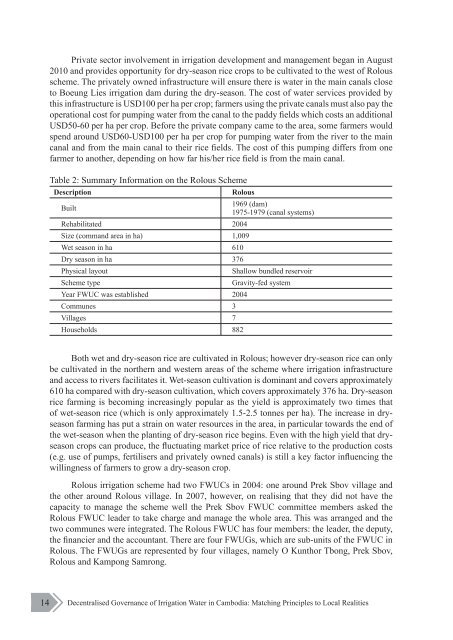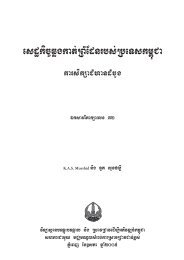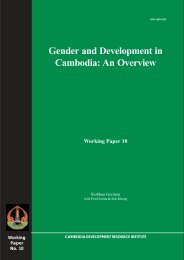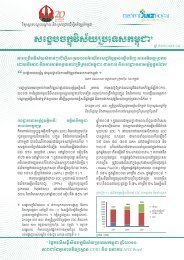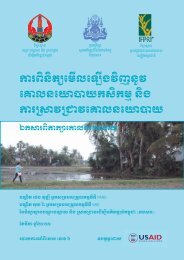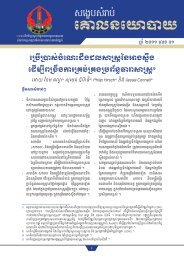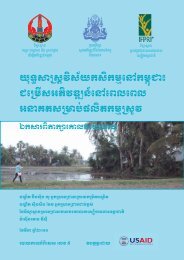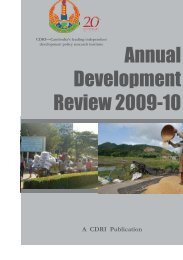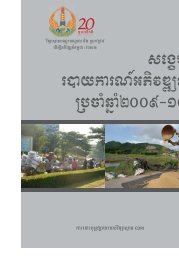62) decentralised governance of irrigation water in cambodia - CDRI
62) decentralised governance of irrigation water in cambodia - CDRI
62) decentralised governance of irrigation water in cambodia - CDRI
You also want an ePaper? Increase the reach of your titles
YUMPU automatically turns print PDFs into web optimized ePapers that Google loves.
Private sector <strong>in</strong>volvement <strong>in</strong> <strong>irrigation</strong> development and management began <strong>in</strong> August<br />
2010 and provides opportunity for dry-season rice crops to be cultivated to the west <strong>of</strong> Rolous<br />
scheme. The privately owned <strong>in</strong>frastructure will ensure there is <strong>water</strong> <strong>in</strong> the ma<strong>in</strong> canals close<br />
to Boeung Lies <strong>irrigation</strong> dam dur<strong>in</strong>g the dry-season. The cost <strong>of</strong> <strong>water</strong> services provided by<br />
this <strong>in</strong>frastructure is USD100 per ha per crop; farmers us<strong>in</strong>g the private canals must also pay the<br />
operational cost for pump<strong>in</strong>g <strong>water</strong> from the canal to the paddy fields which costs an additional<br />
USD50-60 per ha per crop. Before the private company came to the area, some farmers would<br />
spend around USD60-USD100 per ha per crop for pump<strong>in</strong>g <strong>water</strong> from the river to the ma<strong>in</strong><br />
canal and from the ma<strong>in</strong> canal to their rice fields. The cost <strong>of</strong> this pump<strong>in</strong>g differs from one<br />
farmer to another, depend<strong>in</strong>g on how far his/her rice field is from the ma<strong>in</strong> canal.<br />
Table 2: Summary Information on the Rolous Scheme<br />
Description Rolous<br />
Built<br />
1969 (dam)<br />
1975-1979 (canal systems)<br />
Rehabilitated 2004<br />
Size (command area <strong>in</strong> ha) 1,009<br />
Wet season <strong>in</strong> ha 610<br />
Dry season <strong>in</strong> ha 376<br />
Physical layout Shallow bundled reservoir<br />
Scheme type Gravity-fed system<br />
Year FWUC was established 2004<br />
Communes 3<br />
Villages 7<br />
Households 882<br />
Both wet and dry-season rice are cultivated <strong>in</strong> Rolous; however dry-season rice can only<br />
be cultivated <strong>in</strong> the northern and western areas <strong>of</strong> the scheme where <strong>irrigation</strong> <strong>in</strong>frastructure<br />
and access to rivers facilitates it. Wet-season cultivation is dom<strong>in</strong>ant and covers approximately<br />
610 ha compared with dry-season cultivation, which covers approximately 376 ha. Dry-season<br />
rice farm<strong>in</strong>g is becom<strong>in</strong>g <strong>in</strong>creas<strong>in</strong>gly popular as the yield is approximately two times that<br />
<strong>of</strong> wet-season rice (which is only approximately 1.5-2.5 tonnes per ha). The <strong>in</strong>crease <strong>in</strong> dryseason<br />
farm<strong>in</strong>g has put a stra<strong>in</strong> on <strong>water</strong> resources <strong>in</strong> the area, <strong>in</strong> particular towards the end <strong>of</strong><br />
the wet-season when the plant<strong>in</strong>g <strong>of</strong> dry-season rice beg<strong>in</strong>s. Even with the high yield that dryseason<br />
crops can produce, the fluctuat<strong>in</strong>g market price <strong>of</strong> rice relative to the production costs<br />
(e.g. use <strong>of</strong> pumps, fertilisers and privately owned canals) is still a key factor <strong>in</strong>fluenc<strong>in</strong>g the<br />
will<strong>in</strong>gness <strong>of</strong> farmers to grow a dry-season crop.<br />
Rolous <strong>irrigation</strong> scheme had two FWUCs <strong>in</strong> 2004: one around Prek Sbov village and<br />
the other around Rolous village. In 2007, however, on realis<strong>in</strong>g that they did not have the<br />
capacity to manage the scheme well the Prek Sbov FWUC committee members asked the<br />
Rolous FWUC leader to take charge and manage the whole area. This was arranged and the<br />
two communes were <strong>in</strong>tegrated. The Rolous FWUC has four members: the leader, the deputy,<br />
the f<strong>in</strong>ancier and the accountant. There are four FWUGs, which are sub-units <strong>of</strong> the FWUC <strong>in</strong><br />
Rolous. The FWUGs are represented by four villages, namely O Kunthor Tbong, Prek Sbov,<br />
Rolous and Kampong Samrong.<br />
14 Decentralised Governance <strong>of</strong> Irrigation Water <strong>in</strong> Cambodia: Match<strong>in</strong>g Pr<strong>in</strong>ciples to Local Realities


